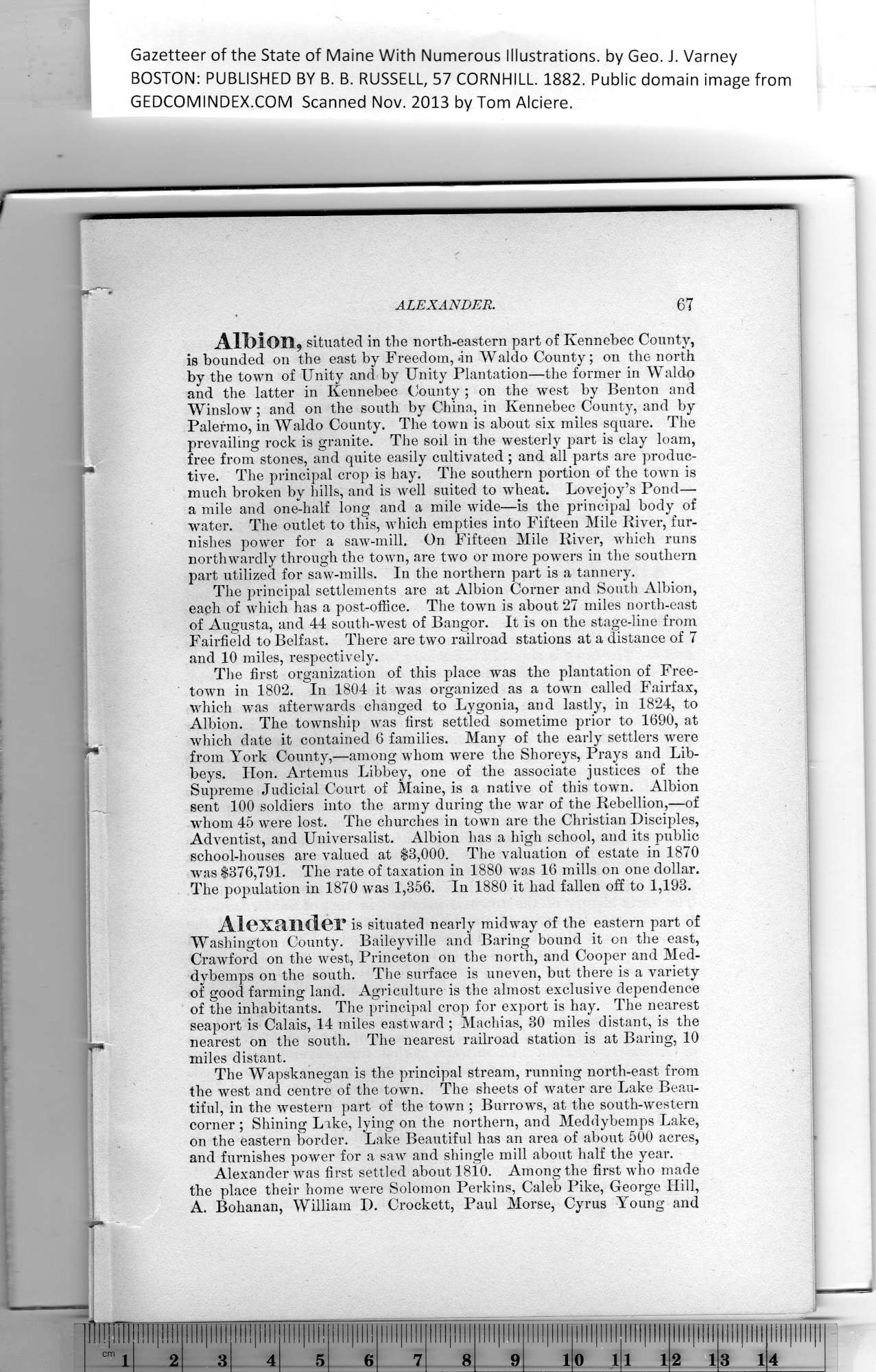|
Gazetteer of the State of Maine With Numerous Illustrations, by Geo. J. Varney
BOSTON: PUBLISHED BY B. B. RUSSELL, 57 CORNHILL. 1882. Public domain image from
ALEXANDER. 67
Albion, situated in the north-eastern part of Kennebec County,
is bounded on the east by Freedom, *in Waldo County; on the north
by the town of Unity and by Unity Plantation—the former in Waldo
and tbe latter in Kennebec County; on the wrnst by Benton and
Winslow; and on the south by China, in Kennebec County, and by
Palermo, in Waldo County. The town is about six miles square. The
prevailing rock is granite. The soil in the westerly part is clay loam,
free from stones, and quite easily cultivated; and all parts are produc-
tive. The principal crop is hay. The southern portion of the town is
much broken by hills, and is well suited to wheat. Lovejoy’s Pond—
a mile and one-half long and a mile wide—is the principal body of
water. The outlet to this, which empties into Fifteen Mile River, fur-
nishes power for a saw-mill. On Fifteen Mile River, which runs
northwardly through the town, are two or more powers in the southern
part utilized for saw-mills. In the northern part is a tannery.
The principal settlements are at Albion Corner and South Albion,
each of which has a post-office. The town is about 27 miles north-east
of Augusta, and 44 south-west of Bangor. It is on the stage-line from
Fairfield to Belfast. There are two railroad stations at a distance of 7
and 10 miles, respectively.
The first organization of this place was the plantation of Free-
town in 1802. In 1804 it was organized as a town called Fairfax,
which w^as afterwards changed to Lygonia, and lastly, in 1824, to
Albion. The township was first settled sometime prior to 1690, at
which date it contained 6 families. Many of the early settlers were
from York County,—among whom were the Shoreys, Prays and Lib-
beys. Hon. Artemus Libbey, one of the associate justices of the
Supreme Judicial Court of Maine, is a native of this town. Albion
sent 100 soldiers into the army during tbe war of the Rebellion,—of
whom 45 were lost. The churches in town are the Christian Disciples,
Adventist, and Universalist. Albion lias a high school, and its public
school-houses are valued at $3,000. The valuation of estate in 1870
was $376,791. The rate of taxation in 1880 was 16 mills on one dollar.
The population in 1870 was 1,356. In 1880 it had fallen off to 1,193.
Alexander is situated nearly midway of the eastern part of
Washington County. Baileyville and Baring bound it on the east,
Crawford on the west, Princeton on tbe north, and Cooper and Med-
dybemps on the south. The surface is uneven, but there is a variety
of good farming land. Agriculture is the almost exclusive dependence
of the inhabitants. The principal crop for export is hay. The nearest
seaport is Calais, 14 miles eastward ; Machias, 30 miles distant, is the
nearest on the south. The nearest railroad station is at Baring, 10
miles distant.
The Wapskanegan is the principal stream, running north-east from
the west and centre of the town. The sheets of water are Lake Beau-
tiful, in the western part of the town ; Burrows, at the south-western
corner; Shining Lake, lying on the northern, and Meddybemps Lake,
on the eastern border. Lake Beautiful has an area of about 500 acres,
and furnishes power for a saw and shingle mill about half the year.
Alexander was first settled about 1810. Among the first who made
the place their home were Solomon Perkins, Caleb Pike, George Hill,
A. Bohanan, William P. Crockett, Paul Morse, Cyrus Young and
PREVIOUS PAGE ... NEXT PAGE
This page was written in HTML using a program written in Python 3.2
|
